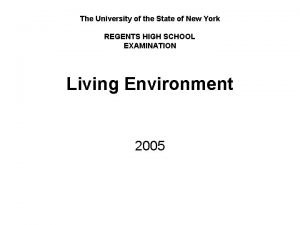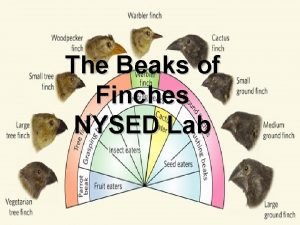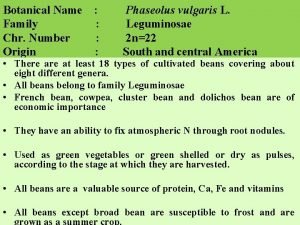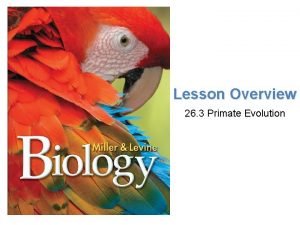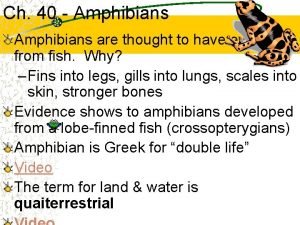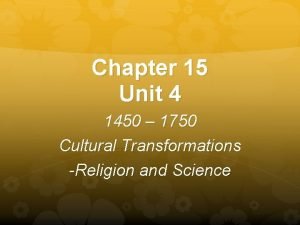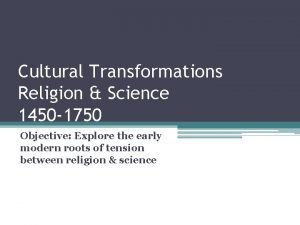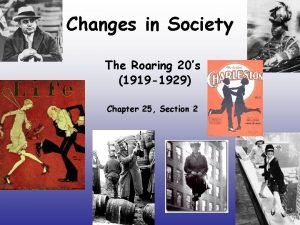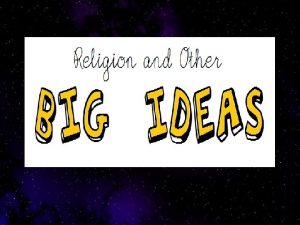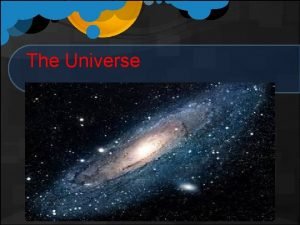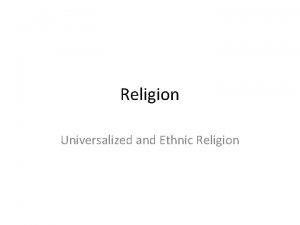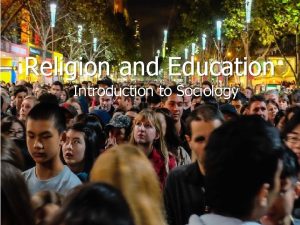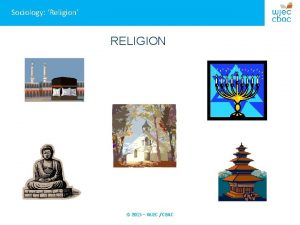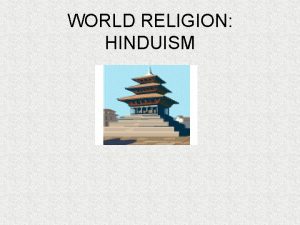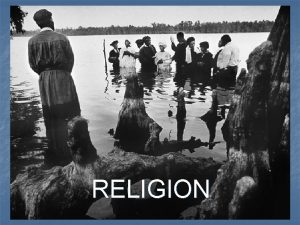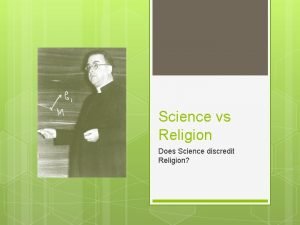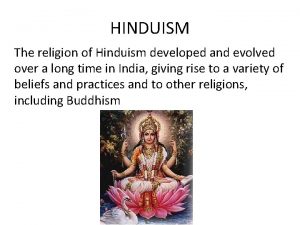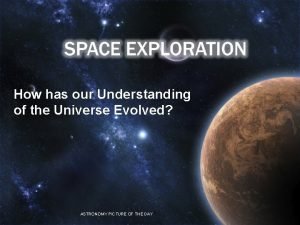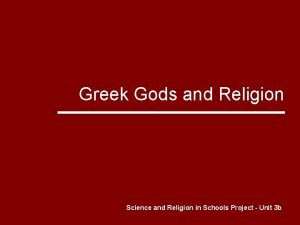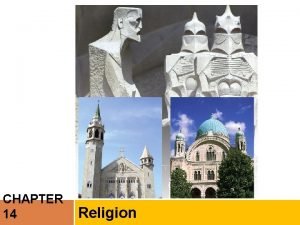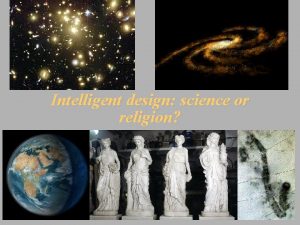How the Universe evolved Science and Religion in




















- Slides: 20

How the Universe evolved Science and Religion in Schools - Unit 4 a The Scientific Account of the Beginning 1

The Big Bang n n n The old Steady State theory has now been rejected The universe and all the structures in it has evolved things have changed over time The initial events are still mysterious, but we understand the broad outline of history from the first few seconds onwards

Simple starting points n n n The universe is 13. 7 billion years old This images dates from 300 000 years into history It shows how matter was arranged in the universe Red means lower density of matter, blue means higher Very little structure in the early universe

Clusters of galaxies n n n Galaxies are grouped in collections or clusters Gravity is pulling these galaxies together Sometimes galaxies collide (see later) On the largest scales, clusters of galaxies are grouped into superclusters Between superclusters there are vast empty regions of space

The large scale structure of the universe n n n This picture has been generated by computer using information from special telescopes Every ‘dot’ is a cluster of galaxies The ‘filaments’ and ‘voids’ can be seen

Colliding galaxies n n 63 million light years from Earth, two galaxies are seen colliding Left hand image shows an over-all view and the galaxies are seen again in more detail on the right Star formation can be seen along the arms where the collision is taking place Such collisions were frequent in the early universe and may have had a lot to do with how stars formed

Triggering star formation n Galaxies in collision 500 million light years from Earth One of the two objects on the right punched a hole through the main galaxy on the image A ring of bright, hot, young stars has been formed as a result of the shock wave from the collision

Star formation in gas clouds n n n M 16 Eagle nebula 6, 500 light years from Earth Long, thin pillars of gas At the end of each pillar, there is a star forming

n n Another image of the Eagle nebula in close up The ‘fingers’ can easily be seen

Life of a star n n n Stars are giant balls of ‘burning’ gas - mostly hydrogen Nuclear reactions in their cores generate energy They also ‘fuse’ light elements (like hydrogen and helium) into heavier ones (like carbon and oxygen) Without stars there would be no life as we understand it We need their warmth, the planets that orbit them and the elements they create

Death of a star n n n When stars die, they shed material into space This includes the heavier elements made during the star’s life As new stars form, they pull these elements towards them

Stars explode n n Sometimes stars die by exploding (supernova) In these gigantic events, the exploding star can be brighter on its own than a whole galaxy The explosion blasts elements into space Heavy elements (iron etc) are made in these explosions

The start of solar systems n n These are images of stars in the Orion nebula Each star (red dot) is about a million years old and surrounded by a ring of dark material The dark material will probably go on to form planets It is the heavier material left over from when the star formed

Evidence for planets n n n The star is Gliese 229, about 18 light-years away It is 20 -50 times heavier than Jupiter, but only about the same size It is roughly the same distance from its star as Pluto is from our Sun

Another possible planet n n 450 light years from Earth It is about 2 -3 times the size of Jupiter Could be a background star (perhaps 2% chance) Possible planet is about 210 billion km from the stars and moving at 10 km/s

Recipe for life n n n Origin of life is not well understood Perhaps the formation of organic molecules in the chemical bath of the Earth was triggered by lightning Perhaps Earth was ‘seeded’ with organic molecules from space Seems likely that to take hold, life would need a set of circumstances not found on all planets Oxygen is a clue to the presence of life

DNA n n n n Self replicating molecule Twin helix (coil) with the two arms cross-linked to each other The two arms can be un-coiled and each can reproduce the other Segments of DNA can also link chemically to specific amino acids Amino acids assembled in sequence build proteins Sequences of DNA can hence make specific proteins DNA contains the information to build copies of itself and specific chemicals within the organism

Cells n n n A vital step in the evolution of life All living forms are composed of one or more cells In complex forms, cells contain nuclei and organelles Organelles carry out various functions within the cell Nucleus contains DNA molecules coiled up into chromosomes Cells probably evolved to protect the DNA from the environment

The tree of life n n n Evolution well established as a biological theory Links Mendel’s idea of genes with Darwin’s natural selection Mutation of the gene gives rise to changes in the organism These changes can be beneficial (more offspring) or not (fewer offspring) Beneficial changes are passed to offspring Gives rise to biological diversity

The brain n n The most complex system known to science One million billion synaptic connections Constructed out of the same material as the rest of the universe (carbon, oxygen, nitrogen etc as made by stars) The seat of consciousness that understands the universe
 Galapagos finches evolved partly due to
Galapagos finches evolved partly due to The beak of finches lab
The beak of finches lab Galapagos finches evolved partly due to
Galapagos finches evolved partly due to Hypocotyl necrosis in french bean is due to
Hypocotyl necrosis in french bean is due to Halloween falls on october 31st every year
Halloween falls on october 31st every year Evolved analytics
Evolved analytics Evolved packet core
Evolved packet core Primate evolution
Primate evolution Amphibians are thought to have evolved from
Amphibians are thought to have evolved from The cult of dionysus theater
The cult of dionysus theater Western religion vs eastern religion
Western religion vs eastern religion What is my favourite subject?
What is my favourite subject? Chapter 15 cultural transformations religion and science
Chapter 15 cultural transformations religion and science Cultural transformations religion and science
Cultural transformations religion and science Science vs religion
Science vs religion Hình ảnh bộ gõ cơ thể búng tay
Hình ảnh bộ gõ cơ thể búng tay Slidetodoc
Slidetodoc Bổ thể
Bổ thể Tỉ lệ cơ thể trẻ em
Tỉ lệ cơ thể trẻ em Gấu đi như thế nào
Gấu đi như thế nào Tư thế worm breton
Tư thế worm breton
